Hypertonie bei Herzinsuffizienz
Werbung
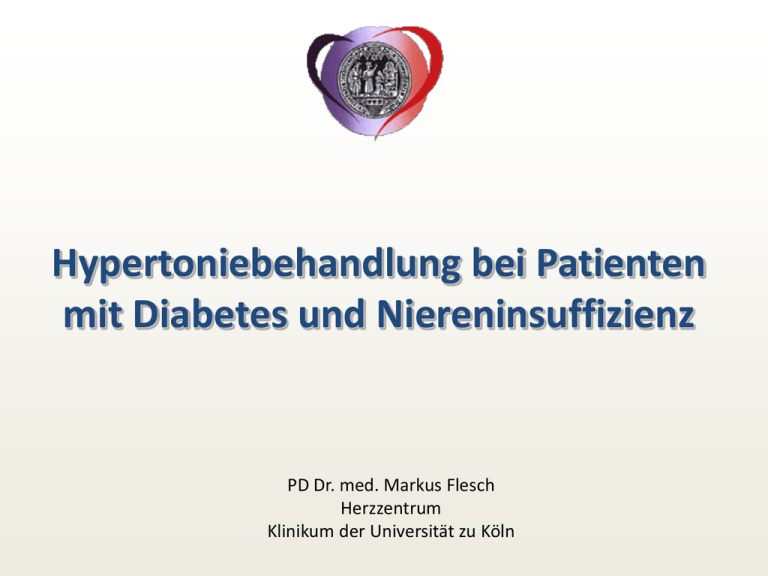
Hypertoniebehandlung bei Patienten mit Diabetes und Niereninsuffizienz PD Dr. med. Markus Flesch Herzzentrum Klinikum der Universität zu Köln Hypertonie-Prävalenz in Deutschland Die 50 Prozent-Regel 16 Mio. Hypertoniker 8 Mio. bekannt 4 Mio. behandelt 2 Mio. < 140/90 mmHg Modifiziert DMW 2001; 126: 1335 Bluthochdrucktherapie Aktuelle Leitlinien • Deutsche Hochdruckliga 2005 http://www.hochdruckliga.de • European Society of Cardiology / European Society of Hypertension 2007 http://www.escardio.org Neue Blutdruckgrenzen Systolisch Diastolisch [mmHg] [mmHg] Optimal <120 <80 Normal 120–129 80–84 Hoch normal 130–139 85–89 Grad-1-Hypertonie (mild) 140–159 90–99 Grad-2-Hypertonie (mittel) 160–179 100–109 Kategorie Grad-3-Hypertonie (schwer) > 180 Isolierte systolische Hypertonie > 140 http://www.hypertonieliga > 110 <90 Neue Blutdruckgrenzen Systolisch Diastolisch [mmHg] [mmHg] Optimal <120 <80 Normal 120–129 80–84 Hoch normal 130–139 85–89 Grad-1-Hypertonie (mild) 140–159 90–99 Grad-2-Hypertonie (mittel) 160–179 100–109 Kategorie Grad-3-Hypertonie (schwer) > 180 Isolierte systolische Hypertonie > 140 http://www.hypertonieliga > 110 <90 Antihypertensive Therapie Einleitung abhängig von 2 hauptsächlichen Kriterien: 1. kardiovaskuläres Gesamtrisiko 2. Höhe des systolischen und diastolischen Blutdrucks. http://www.hypertonieliga Antihypertensive Therapie Einleitung abhängig von 2 hauptsächlichen Kriterien: 1. kardiovaskuläres Gesamtrisiko 2. Höhe des systolischen und diastolischen Blutdrucks. http://www.hypertonieliga ESC-Leitlinie Hypertonie Behandlungsindikationen Eur Heart J 2007 28:1462-1536 Erhöhtes Kardiovaskuläres Risiko Risikofaktoren: Übergewicht Diabetes mellitus LDL-Cholesterin C-reaktives Protein Endorganschäden: Mikroalbuminurie beginnende Niereninsuffizienz linksventrikuläre Hypertrophie Herzinsuffizienz Hochnormaler Blutdruck und kardiovaskuläres Risiko Vasan et al., N Engl J Med. 2001;345(18):1291-7 PROGRESS-Studie 6105 Hypertoniker und Normotoniker nach Schlaganfall Behandlung mit Perindopril und Indapamid Lancet. 2001; 358(9287):1033-41 PROGRESS-Studie 6105 Hypertoniker und Normotoniker nach Schlaganfall Behandlung mit Perindopril und Indapamid Lancet. 2001; 358(9287):1033-41 Schlaganfallrisikoreduktion: 44% bei Hypertonikern 42% bei Normotonikern Wie niedrig soll der Blutdruck gesenkt werden? ABCD-Studie Endpunkt Mikroalbuminurie Intensiv 480 normotensive Diabetiker Intensive diastolische Blutdrucksenkung mit Nisoldipin oder Enalapril = RR diast minus 10 mm Hg Moderate diastolische Blutdrucksenkung mit Placebo N Engl J Med. 2000 ;342(3):145-53 Moderat UKPDS-Studie Anzahl der antihypertensiven Medikamente 1148 Hypertoniker mit Typ 2 – Diabetes Mittleres Alter 56 Jahre Mittlere Blutdruck 160/94 mm Hg Strenge Blutdruckkontrolle Ziel-RR: <150/85 mm Hg Mittlerer RR: 144/82 mm Hg Lasche Blutdruckkontrolle Ziel-RR: < 185/105 mm Hg Mittlerer RR: 154/87 mm Hg UK Prospective Diabetes Study Group, BMJ 1998;317:703-713 UKPDS-Studie Endpunkt: Myokardinfarkt, plötzlicher Tod, Schlaganfall, pAVK, Niereninsuffizienz Strenge Blutdruckkontrolle Mittlerer RR: 144/82 mm Hg Lasche Blutdruckkontrolle Mittlerer RR: 154/87 mm Hg UK Prospective Diabetes Study Group, BMJ 1998;317:703-713 Wie niedrig soll der Blutdruck gesenkt werden? • • • • Allgemein RR < 140/90 mmHg Weitere RR-Senkung falls Patient dies verträgt Diabetiker RR < 130/80 mmHg Nierenkranke RR < 125/75 mmHg Womit soll der Blutdruck gesenkt werden? Womit soll der Blutdruck gesenkt werden? Wie viele Medikamente braucht der Patient? Polypharmazie zur Blutdruckeinstellung Singer, G. M. et al. Hypertension 2002;40:464-469 Womit soll der Blutdruck bei Diabetikern und Nierenpatienten gesenkt werden? SHEP Ergebnisse HCT/Atenolol vs. Placebo Relatives Risiko (95% CI) 1,60 1,40 1,20 1,00 0,80 0,60 0.87 0.63 0.68 0.75 0.46 0,40 0,20 Schlaganfall KHK 8.2 % unter Placebo 5.2 % unter Therapie (ARR 3%) Herzinsuff Kardiovaskuläre Krankheiten Tod JAMA 1991; 265 (24):3255-64. MARVAL-Studie Nephroprotektion durch Valsartan vs. Amlodipin Valsartan 80 or 160 mg/day Post-baseline reduction in BP (mmHg) 0 n=163 n=158 n=163 n=158 Post-baseline reduction in UAER (%) 0 n=163 –10 –5 –6.6 –6.5 Amlodipine 5 or 10 mg/day n=158 –8 –20 –10 –11.2 –11.6 –15 –20 –30 –40 DBP SBP –50 –44 *** UAER = elevated urine albumin excretion Hypertensive und normotensive Patienten mit Typ 2 Diabetes und Mikroalbuminurie; Behandlung mit Valsartan oder Amlodipin über 24 Wochen ***p<0,001 vs. Amlodipin Viberti G, et al. Circulation 2002;106:672–8 RENAAL Losartan bei Diabetikern mit Nephropathie Intention-to-treat analysis % with event 50 Risk Reduction: 16% p=0.02 P 40 1513 patients with type 2 diabetes and nephropathy L 30 Losartan vs. Placebo in addition to conventional antihypertensive treatment 20 10 0 Primary Composite Endpoint: Doubling of Serum Creatinine/ESRD/Death 0 P (+ CT) 762 L (+ CT) 751 12 689 692 24 36 Months 554 583 295 329 Brenner BM et al New Engl J Med 2001; 345(12):861-869 48 36 52 RENAAL First Hospitalization for Heart Failure % with event 20 Risk Reduction: 32% p=0.005 P 15 10 L 5 0 P (+CT) L (+CT) 0 12 762 751 685 701 Brenner BM et al New Engl J Med 2001;345(12):861-869. 24 Months 616 637 36 48 375 388 53 74 Typ 2 – Diabetes AT1-Blockade und Nephropathie 590 hypertensive patients with type 2 diabetes and microalbuminuria Paving, HH, N Engl J Med. 2001;345: 870-8 BENEDICT Bergamo Nephrologic Diabetes Complications Trial 1204 subjects with hypertension and diabetes type 2, no microalbuminuria three years of treatment with trandolapril plus verapamil, trandolapril alone (2 mg per day), verapamil alone (sustained-release formulation, 240 mg per day), or placebo Ruggenenti P et al. N Engl J Med 2004;351:1941-1951 Renoprotektive Effekte von AT1-Blockern: DETAIL, IRMA2, IDNT und RENAAL RENAAL1 3,4 Jahre Losartan 100 mg IRMA22 2 Jahre IDNT2 2,6 Jahre DETAIL2 5 Jahre Irbesartan 300 mg Irbesartan 300 mg Telmisartan 80 mg Rückgänge der GFR (ml/min/1,73 m²/Jahr) 0 -1 -2 -3 -4 -5 -6 1 -3,7 -4,4 -5,7 -5,5 Median Mittelwert Parving et al. N Engl J Med 2001;345:870–878; Brenner et al. N Engl J Med 2001;345:861–869 Lewis et al. N Engl J Med 2001;345:851–860; Barnett et al. N Engl J Med 2004;351:1952–1961 2 Angiotensin II und Nephropathien Glomerulärer Druck Oxidativer Stress Entzündung Angiotensin II Hyperfiltration, Glomerulokapilläre Hypertonie Chronische Nephropathie Brewster, Perazella. Am J Med 2004;116:263–272 Wachstum von Zellen und Gewebe Verlust von Nephronmasse Glomerulosklerose ACE-Inhition vs. AT1R-Blockade in Type 2-Diabetes Glomerular Filtration Rate DETAIL-Study 250 subjects type 2 diabetes and early nephropathy telmisartan (80 mg daily, in 120 subjects) vs. enalapril (20 mg daily, in 130 subjects) Barnett et al., N Engl J Med. 2004;351:1952-61. COOPERATE Anteil d. Patienten mit erreichtem Endpunkt, % 30 25 336 Patienten Trandolapril Losartan 20 15 nicht-diabetische Nephropathie Kombination 10 5 0 0 Zahl d. Pat m. Risiko Losartan 89 Trandolapril 86 Combination 88 Nakao N et al. Lancet. 2003;361:117-124. 6 12 18 24 30 36 Monate nach Randomisierung 88 85 87 84 83 86 79 75 83 65 72 76 59 63 73 47 58 67 RAS-Blockade und Diabetes-Manifestation Losartan Intervention for Endpoint* Reduction in Hypertension - LIFE-Studie Proportion of Patients with First Event (%) 16 14 12 10 Atenolol * CV Mortality Fatal / Non-fatal Stroke Fatal / Non-fatal MI Losartan 8 6 4 9193 hypertensive Patienten mit LVH Follow-Up 4,8 Jahre 2 0 Study Month 0 6 12 18 24 Losartan (n) 4605 4524 4460 4392 4312 Atenolol (n) 4588 4494 4414 4349 4289 Dahlöf, B., et al., Lancet 2002 Komb. Endpunkt: CV-Tod, Schlaganfall, Myokardinfarkt 30 36 42 48 54 60 4247 4189 4112 4047 3897 1889 4205 4135 4066 3992 3821 1854 66 901 87634 LIFE: New Onset Diabetes Intention-to-Treat 0.10 0.09 Atenolol Endpoint Rate 0.08 0.07 0.06 Losartan 0.05 0.04 0.03 0.02 Adjusted Risk Reduction 25%, p<0.001 Unadjusted Risk Reduction 25%, p<0.001 0.01 0.00 Study Day 0 180 360 540 B Dahlof et al. Lancet 2002;359:995-1003 720 900 1080 1260 1440 1620 1800 1980 Erstmanifestation Diabetes mellitus bei AT1-Blockade in klinischen Studien LIFE VALUE Losartan vs. Atenolol -25% Valsartan vs. Amlodipin -23% CHARM-Preserved Candesartan vs. Placebo -39% Lancet (2002) 359:995 Lancet (2004) 363:2049 Circulation (2005) 112:48 BLUT Insulin Glukose Insulinrezeptor Aktivierung PI3-Kinase Inaktivierung Glukosetransporter MUSKELZELLE Anan et al (2004), Metabolism 53 (6) Higashiura et al (1999), J Hum Hypertens 13 (Suppl 1) Angiotensin II Reduzierte Insulin-vermittelte Glukoseaufnahme bei Hypertonikern 7 Glukoseaufnahme 6 [mg/min/kg] 5 4 3 2 1 0 Kontrollen Hypertonie Ferrannini et al. N. Engl. J. Med. (1987) 317:350 Typ 2-Diabetes und Nephropathie Einfluss von Losartan auf die Glukosekonzentration Jin HM et al., Nephrol Dial Transplant 2007; 22: 1943-1949 LIFE – Diabetes Subgroup: Total Mortality 24 Proportion of Patients, % 20 Atenolol 16 12 8 Losartan 4 RRR = 39%; p=0·002 0 0 6 12 18 L H Lindholm et al. Lancet 2002;359:1004-1010 24 30 36 Study Month 42 48 54 60 66 Hypertoniebehandlung – Was ist neu? Was ist wichtig? • Milder Hypertonus bereits ab RRdiast > 90 mm Hg, RRsyst> 140 mm Hg • Bei erhöhtem kardiovaskulären Risiko Behandlung des hochnormalen RR • Strengste RR-Einstellung bei Diabetes, Nephropathie und Myokardhypertrophie • Günstiger Effekt einer RAS-Blockade auf Diabetesmanifestation und Nephropathie ESC-Guideline 2007: Hypertension and Metabolic Syndrom • In all individuals with metabolic syndrome, intense lifestyle measures should be adopted. When there is hypertension drug treatment should start with a drug unlikely to facilitate onset to diabetes. Therefore a blocker of the renin-angiotensin system should be used followed, if needed, by the addition of a calcium antagonist or a low-dose thiazide diuretic. It appears desirable to bring BP to the normal range. http://www.escardio.org/knowledge/guidelines/Mngt_Arterial_Hypertension.htm?escid=44618 ESC-Guideline 2007: Hypertension and Diabetes • A blocker of the renin-angiotensin system should be a regular component of combination treatment ... • Microalbuminuria should prompt the use of antihypertensive drug treatment also when initial BP is in the high normal range. … Some additional protection can be obtained by the use of a blocker of the renin-angiotensin system (either an angiotensin receptor antagonist or an ACE inhibitor). http://www.escardio.org/knowledge/guidelines/Mngt_Arterial_Hypertension.htm?escid=44618 ESC-Guideline 2007: Hypertension and Renal Failure • Protection against progression of renal dysfunction has two main requirements: a) strict blood pressure control (<130/80 mmHg and even lower if proteinuria is >1 g/day); b) lowering proteinuria to values as near to normal as possible. • To reduce proteinuria, an angiotensin receptor blocker, an ACE inhibitor or a combination of both are required. http://www.escardio.org/knowledge/guidelines/Mngt_Arterial_Hypertension.htm?escid=44618
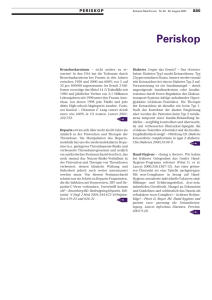
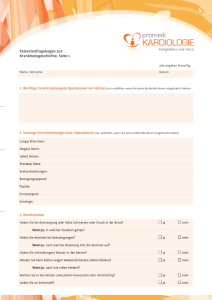
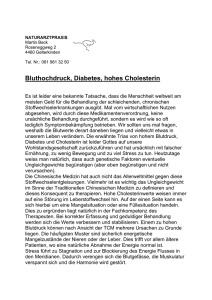
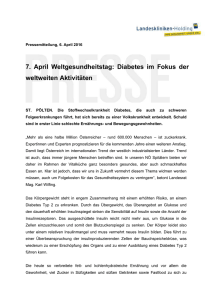
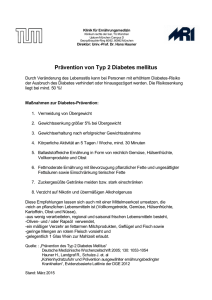
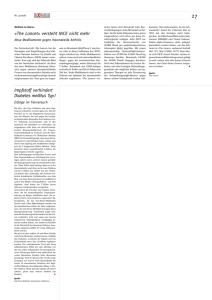
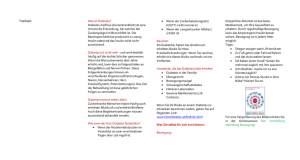
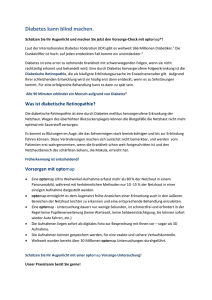
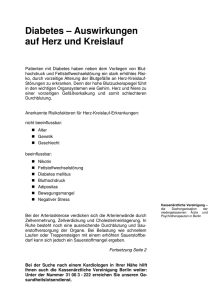
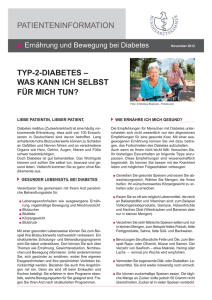
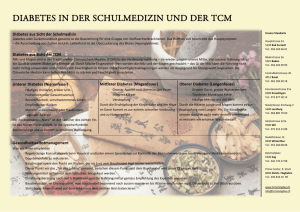
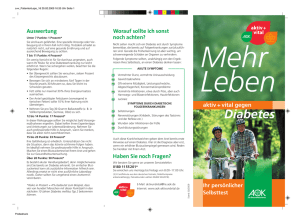
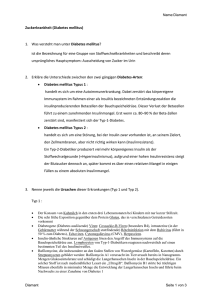
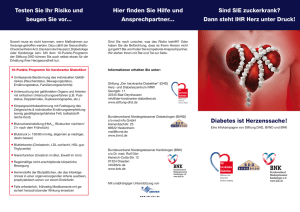
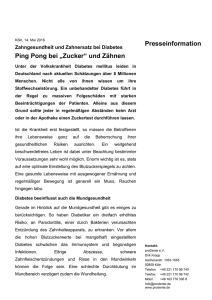
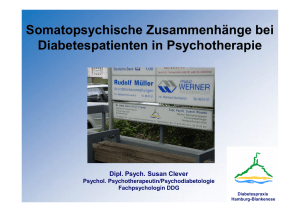
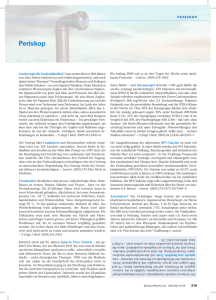
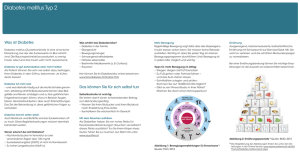
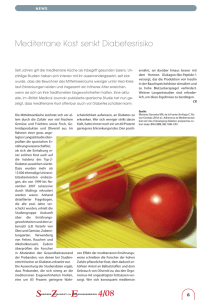
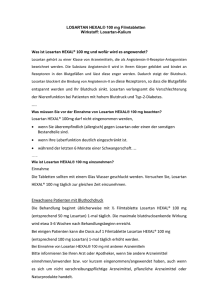
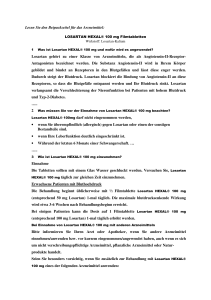
![(a-t 7 [1996], 65). - Arznei](http://s1.studylibde.com/store/data/002533912_1-a6bfbf4bcd5835716487fca2d38acda8-300x300.png)